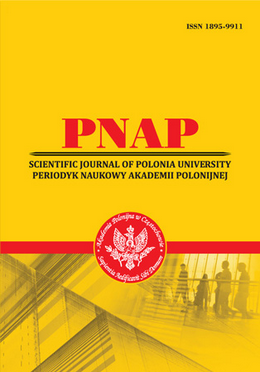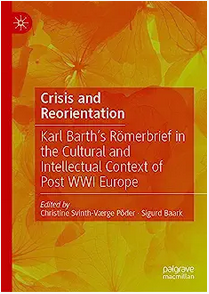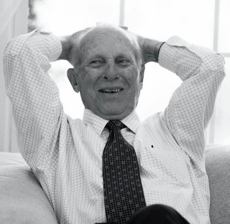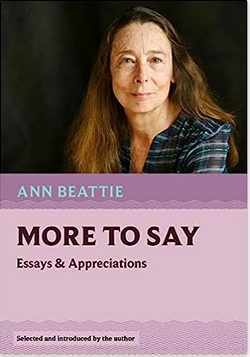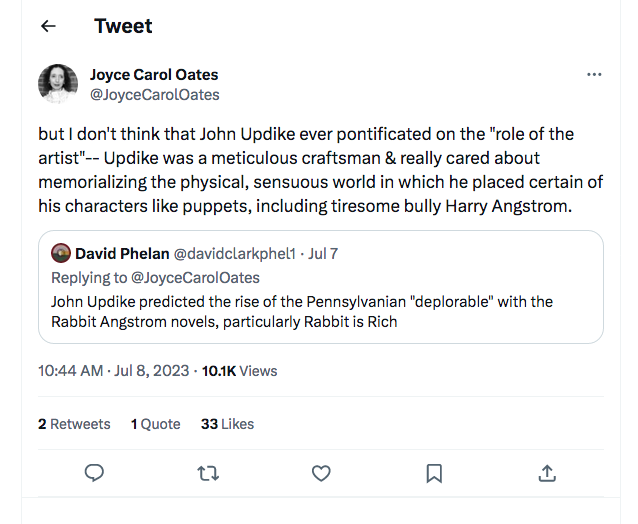
Polish journal features article on the ordinary American in Updike’s short stories
PNAP: Scientific Journal of Polonia University in Czestochowa, Poland published an academic article by Olena Bezhan on “The Image of ‘An Ordinary American’ in J. Updike’s Short Stories” in their most recent issue. Bezhan, an associate professor at Odesa National I.I. Mechnikov University in Ukraine, called Updike “a barometer of American sentiment” and focused on the short story “Pigeon Feathers.” Birds, Bezhan wrote, are “an essential element of various mythopoetic traditions” that are “widely represented in symbolism and emblematics. Birds as embodiments of deity play an important role in myths about the creation of the world: the cosmic spirit in the form of a bird or a bird as an assistant to the divine creator, a giant bird as a common image of the Creator.”
“The most famous ‘function’ of the bird is its personification of the human soul. The idea of the soul in the form of a bird is present in ancient cultures, such as Egypt, Greece, China and Siberia, South America, etc. Thus, the bird is a symbol of the soul, and in the Bible it is a dove that arrives with the news that Mary will give birth to the son of God. The fact that the boy has to shoot the pigeons and is forced to experience all these negative emotions, combined with the impressive hunting scene that the reader watches, can-and-should-be interpreted as David being required to part with his soul in order to move into the adult state, but as we see, he cannot get rid of his soul. However, it turns out that killing birds does not help the hero come to terms with the thought of death—the expected mental breakthrough did not occur. Realizing this, we can say that the mystery of death, as well as the desire to live, remain constant categories for the writer, in his opinion, this mystery accompanies a person all his life: ‘with a feminine, slipping sensation along his nerves that seemed to give the air hands, he was robed in this certainty: that the God who had lavished such craft upon these worthless birds would not destroy His whole Creation by refusing to let David live forever’.”
Is Henry Bech an act of cultural appropriation?
Writer Jennifer Anne Moses said she doesn’t think so.
In “Artists, like myself, appropriate culture—and that’s OK,” Moses defended a white poet who came under fire in The Nation for a point-of-view poem from the perspective of a black homeless person.
“I’m white and Jewish. Post-college, I wrote about people who look like me. Then I moved to Baton Rouge, Louisiana, where I volunteered in an AIDS hospice, largely among African-American, underprivileged, full-Gospel Christians. I sat with them, held their hands, and heard their stories. I did this for 10 years, and when I moved back east, I turned their real lives into fiction,” Moses wrote.
“Was I guilty of cultural appropriation? A few people who read the book said I was. But those in the hospice who read my book thanked me. To this day, I’m glad I did what I did, because if I hadn’t written about this one tiny corner of humanity, then nobody would have.
“True, I had little in common with the people who inspired the characters I conjured—other than, you know, we all bleed red.
“Who has the right to write it?
“If artists shied away from using the specifics of cultures other than their own, including oppressed and marginalized ones, the world would not have works such as Sophie’s Choice, Sounder, The Canterbury Tales, Uncle Tom’s Cabin, Othello, Tobacco Road, or Heart of Darkness. So what if George Eliot (Mary Anne Evans) was about as Jewish as George Washington? Had she not been the genius she was and dreamed up the conflicted Jew Daniel Deronda, he, and his book, would simply not exist.
“Yet many smart people are appalled by ‘cultural appropriation,’ comparing it to a kind of ‘stealing.’ If whites (or members of other privileged groups) borrow bits of a minority or oppressed group’s culture, they say, they’re depriving that group of a chance to tell its own stories.
“But is that really true? The fact that Stevie Ray Vaughan (who was white) sang the blues certainly didn’t mean that B.B. King (who was black) couldn’t sing them, too. John Updike (who was a gentile) wrote several books featuring Jewish characters, but that sure didn’t mean that Philip Roth (who was Jewish) couldn’t write about them too.”
Moses is the author of Visiting Hours, Tales from My Closet, Bagels and Grits: A Jew on the Bayou, The Art of Dumpster Diving, The Book of Joshua, and The Man Who Loved His Wife. Read her entire August 22, 2018 ed-op piece in The Daily American.
AI John Updike? The man would be horrified, wouldn’t he?
Dark web. Deep AI. Sounds sinister, doesn’t it? And one could picture it becoming so in an Updike novel . . . or at least something that leads to unintended consequences. Now you can “chat” with John Updike via Deep AI (artificial intelligence). Fans of Updike know how much he loved words and the physicality of words on the page and books in the hand, and know how much he even resented interviewers and biographers for “mining” his life. Certainly he would find this unsettling, wouldn’t he? Some readers will embrace this; others will not even want to click on this Pandora’s Box. But here it is.
New book on Karl Barth and crisis-reorientation includes Updike chapter
Crisis and Reorientation: Karl Barth’s Römerbrief in the Cultural and Intellectual Context of Post WWI Europe, edited by Christine Svinth-Værge Põder and Sigurd Baark, features a chapter by Bent Flemming Nielsen on “A Literary Reception of Karl Barth’s Römerbrief: On Barthianism in John Updike’s Roger’s Version.”
Like the editors, Nielsen teaches in the Section of Systematic Theology, Faculty of Theology, at the University of Copenhagen in Copenhagen, Denmark.
Abstract
American author John Hoyer Updike (1932–2009) once said, “Karl Barth was my hero among theologians.” Updike found Barth’s early writings from Der Römerbrief (1922) until Fides Quaerens Intellectum (1931) especially interesting. Moreover, Barthian motives also played a role in Updike’s novels. This becomes most obvious in Roger’s Version (1986), a novel about a theological professor, Roger Lambert. The novel addresses Barthian topics such as revelation and knowledge of God in modernity, narrated through vivid examples of human arrogance, guilt, and infidelity. In addition to presenting a body of Updike’s conscious stylistic writing, this chapter delves into Barthian theological perspectives in Roger’s Version and Updike’s personal convictions. The chapter emphasizes mainly the dialectic “wisdom of death” as a key to interpreting the book. (The orality of the presentation has been retained to some extent.)
How do you describe Wes Anderson’s characters? By invoking John Updike
In “The Definitive Ranking of Every Single Wes Anderson Character,” superfans Mark Asch, Charles Bramesco and Jesse Hassenberger took on the gargantuan job of considering how “Anderson collects things and people” and trying to assess the “many traits that make a Wes Anderson character memorable or quintessential to the filmmaker’s project—intellectual curiosity, reckless rambunctiousness, melancholy that clings like a fog, lovable selfishness, epigrammatic wit, sartorial fastidiousness, facial symmetry—” and rank the characters.
“One recurring theme of these blurbs will prove to be family; another will prove to be the lure of the past for Anderson and his characters. Meanwhile, a recurring theme of all the horrible A.I. art generated from a ‘[X] directed by Wes Anderson’ prompt that you may have seen chumming your Twitter feed recently is visual symmetry. In ‘The Guardians,’ a 2001 short story by John Updike, the protagonist, raised by two parents and two grandparents, ‘felt the four adults as sides of a perfect square, with a diagonal from each corner to a central point. He was that point, protected on all sides, loved from every direction.’ We meet many of Anderson’s characters already in mourning, sensing love’s enveloping geometry thrown out of balance, and seeking a return to the symmetry of their once-intact families. Everything is in its right place in every one of Anderson’s shots, but these ghosts [The Dead: Chas’s wife in The Royal Tenenbaums, Auggie’s wife in Asteroid City, Max’s mom in Rushmore, the Whitman patriarch in The Darjeeling Limited; Esteban in The Life Aquatic, everyone, eventually] remind us that this, too, is a temporary state.”
Updike cited in political column
America is more politically divided than ever, but it seems ironic that John Updike, who had been accused of being not political enough in his writing, recently turned up in a political column.
Writing for the blog PowerLine, Scott Johnson invoked Updike for an ed-op piece titled “Six Theses on Hunter Biden’s Plea Deal.” In a wryly written column, Johnson wrote, “We can see why President Biden is proud of his son. He’s not only the smartest person he knows—he’s smarter than President Biden, anyway—he has unbelievable skating ability. Having declared his knowledge of Hunter’s innocence of wrongdoing for several years now, President Biden can now praise Hunter’s endurance in the face of this great injustice. In the same sense, President Biden is innocent too! Only more so.
“One of John Updike’s stories about his alter ego Henry Bech is titled ‘Bech Third-Worlds It.’ (The story is collected in Bech Is Back.) The United States has been Third-Worlding it for a while now. With the federal indictment of President Trump pending in the documents case, the Hunter Biden case reminds us that our system of justice has devolved into a ritualized Third World farce. It is useful in that sense.”
In Memoriam: Richard “Dick” Rhoda
Former multi-sport athlete Richard “Dick” Rhoda died June 12, 2023 at the age of 92. Born in Shillington, he was the son of textile mill worker William “Wit” Rhoda and hospital administrator Kathryn Long.
At Shillington High School, Rhoda was on the varsity football, basketball, track, and swim teams. John Updike’s father, Wesley, coached the swim team and was an assistant coach on the football team, and Rhoda’s son, Jeff, recalled his father telling him that a “classmate, John Updike, would stop by his family home with his father to help count the concession stand proceeds after games.”
“My father had a Huck Finn childhood,” Jeff Rhoda said. “He hunted with his father and trapped muskrats before school and then sold them for 10 cents each.” The younger Rhoda also said his father “grew up in Amish country and enjoyed his scrapple and shoofly pie.” He added, “My parents rarely missed a happy hour at the end of the day. My father had a daily cigar.”
Rhoda later attended Albright College, where he was the starting point guard on the basketball team, after which he received a degree in pharmacy from Philadelphia Pharmaceutical (later Philadelphia College of the Sciences). He worked as a pharmacist for most of his life, and also coached youth football in his community. He is survived by his wife of 69 years, Irene McLaughlin, a retired Baltimore County Library administrator; two sons, Rich Rhoda of Centerville, Ohio and Jeff Rhoda of Baltimore; a daughter, Sharon Hovde of Madison, Wis.; six grandchildren and six great grandchildren. The John Updike Society offers their condolences.
A life celebration will be held August 8 on what would have been the couple’s 70th wedding anniversary at a location to be announced.
Read the full obituary.
Ann Beattie speaks to Updike’s descriptive powers
In a March 2023 interview with V.V. Ganeshananthan and Whitney Terrell, Ann Beattie talked about her new collection of essays, More to Say: Essays and Appreciations, which contains an essat on “John Updike’s Sense of Wonder.” Beattie was the keynote speaker at the 1st Biennial John Updike Society Conference in Reading, Pa., back in 2010, and a version of her talk—and this chapter—was published by The John Updike Review in 2011.
The Lit Hub-hosted interview series noted that in the interview Beattie discussed “her recent LitHub essay about Donald Barthelme’s short story ‘The Balloon’ and the Chinese spy balloon. She also talks about her recently published first collection of essays, More to Say: Essays and Appreciations, in which she writes about the work of authors, photographers, and artists she admires, including Elmore Leonard, Sally Mann, John Loengard, and her own husband, visual artist Lincoln Perry.
“Beattie explains why as a nonfiction writer, she prefers close looking and reading; considers defamiliarization in the hands of Barthelme and Alice Munro; analyzes former visual artist John Updike’s depiction of the natural world; and reflects on developing increased comfort with writing about visual art. She also reads excerpts from both her Lit Hub piece and the essay collection.”
Here’s the link to the Lit Hub interview.
Updike on Pulitzer Prize-winner Colson Whitehead
Ninety-three American writers have won the Pulitzer Prize for Fiction since the award was first given in 1918 to Ernest Poole for the novel His Family. Only four writers have won the prize more than once: Booth Tarkington (The Magnificent Ambersons, Alice Adams), William Faulkner (A Fable, The Reivers), John Updike (Rabbit Is Rich, Rabbit at Rest), and Colson Whitehead (The Underground Railroad, The Nickel Boys).
Erin McCarthy’s reasons for writing about “7 Pulitzer Prize-Winning Novelists” for Mental Floss aren’t divulged—only “here are a few other authors whose books have nabbed the prestigious prize”—but she reminds us of Updike’s response to Whitehead, who was nominated for his first Pulitzer in 2002 and won in 2017 and 2020, after Updike had died.
Updike said that Whitehead’s writing “does what writing should do. It refreshes our sense of the world.” Years later, the Pulitzer jury would echo that in calling The Underground Railroad “a smart melding of realism and allegory that combines the violence of slavery and the drama of escape in a myth that speaks to contemporary America.”
Of Updike, McCarthy wrote, “John Updike, the author of more than 25 novels, won Pulitzers for two books in his series that follows ex-athlete Harry ‘Rabbit’ Angstrom: Rabbit Is Rich (1981) and Rabbit at Rest (1990), the latter of which ends with Rabbit’s death. In 1997, Updike described ending the series as ‘kind of a relief. … It wasn’t as sad for me as perhaps for some of my readers. Writers are cruel. Authors are cruel. We make, and we destroy.’ The character of Rabbit, Updike said, ‘opened me up. As a writer, I could see things through him that I couldn’t see by any other means.'”

